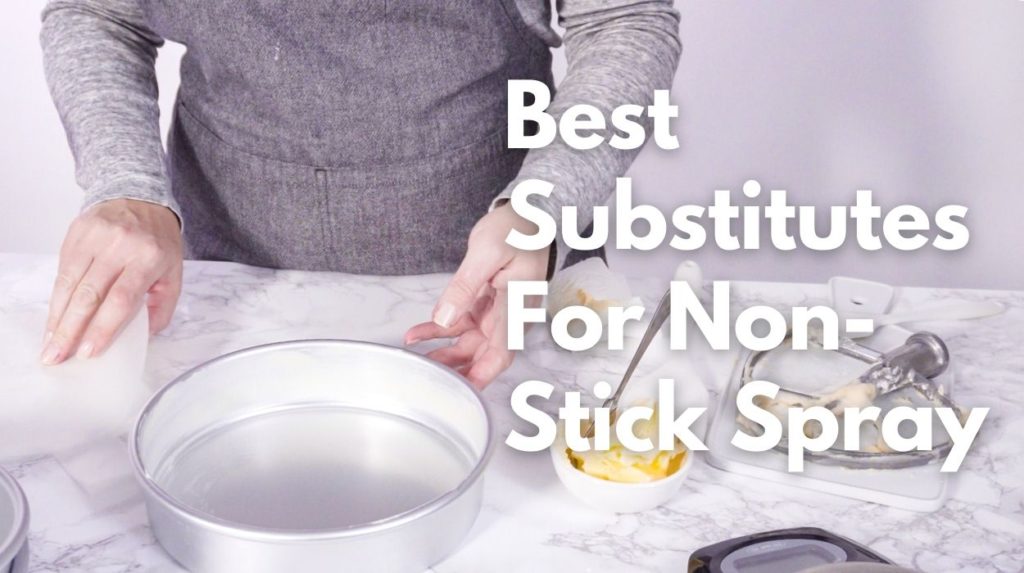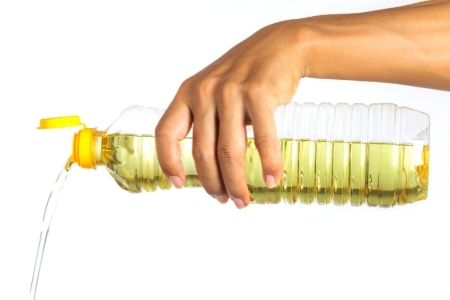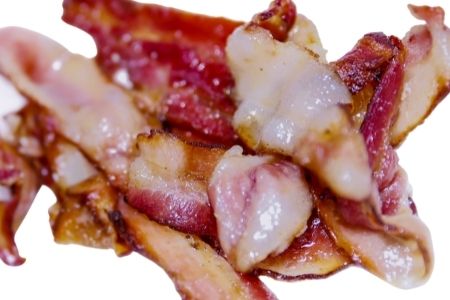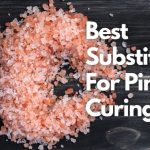
A quick spritz of non-stick cooking spray is a prerequisite in baking delicious brownies or mouth-watering casseroles. While a non-stick spray is often preferred for such situations, one might not always have it at their fingertips. In such cases, you will have to resort to other options.
You can try other substitutes like butter, parchment paper, olive oil, etc. For those who do not wish to substitute the iconic non-stick spray, we have also included a simple way through which you can prepare a DIY non-stick cooking spray.
Does that sound intriguing to you? If yes, let’s get started with the article.
8 Best Non-Stick Cooking Spray Substitutes
Since the goal of a non-stick spray is to prevent your food from getting stuck to the pan, it is best to keep that in mind while choosing its substitutes:
1. Butter

Butter is something that is found at the back of everybody’s pantry. Besides making beautiful sandwiches with it, you can also use it as a non-stick spray substitute.
Since butter melts evenly and quickly, you can get on with your baking without worrying about the food sticking to the pan.
While it might not provide a thin and even coat, the flavors and aroma make up for it. By replacing a non-stick spray with butter, you will get additional flavors, apart from the non-stickiness.
You can either take a small slice or cube of butter and spread it evenly across the pan. If not, you can hold it over the pan and rub it to melt it immediately.
However, do consider the additional calories that come with butter.
2. Parchment Paper

If the additional calories of butter concern you, we suggest using parchment paper instead. This works as a disposable substitute for non-stick spray.
A parchment paper, also known as vegetable parchment, is made with a cellulose-based composite that gets processed. This gives it the necessary non-stickiness, humidity resistance, and grease resistance.
Unlike butter, you shall not experience any liquid with parchment paper. In this way, you will not get any additional flavors to your dish.
It works well with baking goods since it holds the batter together. You can use a single roll and spread it across the pan. Once the baking is done, you can throw it away.
3. Olive Oil

If you want your cooking to have a variety of flavors, similar to fruits and herbs, along with being aromatic heaven, we suggest olive oil.
Olive oil will quickly spread all across the pan for faster and easier cooking. If you are using a grill, you can pour it on a paper towel and rub it all over it.
The taste and aroma of olive oil depending on your choice of brand. It is best to go with a qualitative extra virgin olive oil if you cook something sweet. If you want something nutty and peppery, it is best to go with qualitative non-virgin olive oil.
The nutritional factor of extra virgin olive oil must also be considered. For example, it is filled with antioxidants and healthy fats that protect your heart. Moreover, it is said to reduce the chances of breast cancer and type II diabetes.
4. Vegetable Oil

Everybody might not prefer the aroma and taste of olive oil. Some people would want their food to have its original taste rather than being influenced by the taste of any additional oil.
If you feel the same, we’d suggest using vegetable oil instead of olive oil.
Since vegetable oil is highly processed, it shall not bring any additional flavor to your dish, thereby keeping it neutral.
At the same time, it works well as a replacement for non-stick spray. Simply pour it into the pan and spread it with a brush or paper towel. A little bit of it will go a long way in preventing your food from getting stuck to the pan.
5. Bacon Fat

If you have recently made bacon or have bacon fat stored in your refrigerator, it is time to put it to use. Of course, who would mind the extra zinginess that comes from bacon fat?
Just like any regular oil, you can pour some bacon fat into the fat and spread it before cooking. But be wary of the proportion because you can easily make your fat extra greasy with bacon fat.
As a thumb rule, reduce the proportion of bacon fat as compared to other substitutes. For example, an ideal proportion of bacon fat for vegetable oil would be 1:2.
Apart from making your food taste better, bacon fat also has several nutritional benefits. With its high protein and oleic acid composition, it will make you feel full, thereby reducing the chances of overeating.
6. Flour Coating

Flour can prove to be an effective way of cooking brownies and meat without getting any part of the food stuck to the pan.
Not only is flour coating one of the most traditional ways, but it is also one of the most effective ones.
You can either use one type of flour or mix it up and coat the bottom of the pan.
If you bake regularly, we’d suggest preparing a mixture of flour and vegetable oil. Such a coating will seal the moisture from the food, add a crunchy texture, and give your food items a beautiful brown color.
7. Lard

If you are a non-vegetarian, lard is a suitable substitute for non-stick spray. Since it is only semi-solid fat obtained from the rendering of the pig’s fatty issue, it might not appeal to vegetarians.
Regardless, lard can be used the same as butter. You can spread it all over the pan before cooking your sausages, chicken, and fillings.
As opposed to your regular butter, lard will add a certain amount of flakiness to the dish.
Moreover, lard is a potent source of good fat, something that will improve heart health. In addition to that, it maintains healthy cells and reduces the risk of depression due to the presence of oleic acid.
8. Vegetable Shortening
Vegetable shortening is an adequate substitute for non-stick spray or butter. It is vegetable oil mixed with hydrogen, with a similar texture to butter. However, it does not contain any sort of aroma or flavor.
Since vegetable shortening is solid at room temperature, you can cut a slice of it and rub it all over the pan.
Vegetable shortening coats the flour in the dough and prevents it from transforming into gluten. In this way, the dough does not stick to the pan. Moreover, it provides a crisp finish to your cooking.
Vegetable shortening lowers cholesterol levels and prevents the risk of heart illnesses.
DIY Non-Stick Cooking Spray
If the aforementioned substitutes are not available at your disposal, or you can’t seem to part ways with your non-stick spray, you can prepare one for yourself at home.
Method 1:

Requirements:
- Spray bottle
- Water
- Any cooking oil
Steps:
- Mix 1 ¼ cup of water and ¼ cup of oil.
- Mix it well and pour it into a spray bottle.
- Store it in a dark and cool place and shake it well before using.
Method 2
Requirements:
- Airtight Container
- Canola oil
- Vegetable shortening
- Flour
Steps:
- Mix canola oil and vegetable shortening in a 1:1 proportion.
- Add flour and mix it well.
- Transfer it to the airtight container.
- Pour the required amount of it into the pan to grease it.
Method 3
If you have lecithin, which is an emulsifier that prevents the staling of doughs and batters, you can try this method.
Requirements:
- Spray bottle
- Water
- Vegetable oil
- Lecithin
Steps:
- Mix water and oil in the proportion of 2:1.
- Pour it into the spray bottle.
- Add lecithin.
- Shake well and store it in a dry and cool place.
Tips for Using a Non-Stick Spray
Several people end up using the non-stick spray in the wrong manner and end up blaming the product.
But the following tips will save you from falling into that category:
- Spray it evenly all across the pan. Cover the bottom as well as the edges to prevent the sides of your food from getting stuck to the pan.
- Don’t overdo it. Spraying too much of it will cause an additional build-up over your food. So, limit it to just a quick and even coating.
- Store it in a cool and dry place, preferably away from direct sunlight.
- Aside from cooking, you can also use the non-stick spray in measuring cups to avoid leaving behind any residue.
- Spray a little bit of it on the cooling rack to avoid getting your desserts stuck to it.
Related Questions
How do you spray cooking oil without a sprayer?
If you do not have a spray bottle, you can simply pour some vegetable oil on a paper towel and rub it all over the pan. You can cover the base as well as the edges, depending on your style of cooking.
Is non-stick spray flammable?
The aerosol cans of non-stick spray are flammable, so it is best to keep them away from heat or stove. You must keep them in a cool and dark place, preferably away from direct sunlight.
Can I use a non-stick spray in my air fryer?
No, it is not advisable to use a non-stick spray in the air fryer because the harsh agents of the aerosol can harm the basket. Instead, it is best to use a bottle or mister to grease the basket of your air fryer.
Takeaway
Working without a non-stick cooking spray can be challenging, especially if you are used to it. However, you can give your non-stick spray a break by trying out other substitutes like butter, olive oil, bacon fat, etc. Avoid going overboard with any of the substitutes, especially butter and lard, if you want to maintain the calorie content of your food.



